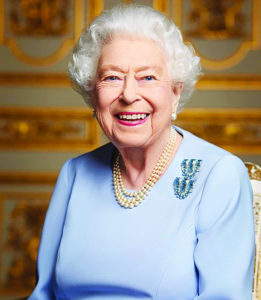
Anguillians, and the rest of the world joined the nation of Great Britain, and its other realms and territories, in a final farewell to the late Sovereign Queen Elizabeth II, with a military procession and state funeral on Monday, September 19, 2022.
Anguilla’s Governor, Dileeni Daniel-Selvaratnam, and Premier, Dr Ellis Webster, were among world leaders, and foreign royalty, who joined King Charles III and the Royal Family for the funeral service at Westminster Abbey.
The day began in sombre pageantry as the Queen’s lying-in-state in Westminster Hall had ended and her coffin was mounted on the State Gun Carriage of the Royal Navy, drawn by 142 sailors in a solemn procession to Westminster Abbey.
King Charles III walked alongside the coffin with his siblings, the Princess Royal, Princess Anne, and Princes Andrew and Edward. The Prince of Wales and the Duke of Sussex walked side-by-side behind their father along a route lined by representatives of all parts of the military.
Thousands of people packed Windsor’s Long Walk as the Queen made her last journey to the castle, where she and Prince Philip had spent the Covid lockdown.
As the Queen’s coffin passed Buckingham Palace for the last time, staff stood outside to say their final goodbyes.
The funeral cortege then drove the 28 miles from London to Windsor, along a route that avoided motorways – to allow as many as possible to pay their final respects.
Throughout the route, thousands of mourners lined up to make their own emotional farewell – some with tears, some with applause and others with flowers strewn at the hearse.
As the funeral procession entered the Abbey, world leaders, politicians and foreign royalty stood as the coffin was carried up the aisle to be placed on a catafalque – draped in the royal standard with the Imperial State Crown, orb and sceptre on top.
A unique floral wreath from the Queen’s son, King Charles III, was prominently displayed on top of the coffin. A handwritten message from the King – “In loving and devoted memory, Charles R” – was placed in the wreath of flowers cut from the gardens of Buckingham Palace, Highgrove House and Clarence House at his request.
Members of the Royal Family were prominently seated together in the Abbey. Some of the youngest members of the family were notably in attendance at the service – the Queen’s great-grandchildren Prince George and Princess Charlotte, aged nine and seven, and sat with their parents the Prince and Princess of Wales.
Prime Minister Liz Truss and her husband were present alongside cabinet ministers and all of the UK’s surviving former prime ministers. They were seated in the abbey’s quire.
Presidents, representatives of foreign royal families, and heads of government, were also present and joined the 2,000-member congregation at the Abbey for the funeral service.
At the service, the Dean of Westminster paid tribute to the Queen’s “lifelong sense of duty”, and the Rev David Hoyle spoke of her “unswerving commitment to a high calling, over so many years, as Queen and Head of the Commonwealth”.
The Archbishop of Canterbury, Justin Welby, said: “People of loving service are rare in any walk of life. Leaders of loving service are still rarer.
“But in all cases, those who serve will be loved and remembered, when those who cling to power and privileges are long forgotten.”
Westminster Abbey holds much of the late Queen’s own personal history. It is here where she was married, and where her coronation took place. Psalm 23 – The Lord Is My Shepherd, was sung at her wedding, and was also heard at her funeral service.
Towards the end of the service, the nation came to a standstill for two minutes’ silence, then the Last Post was played – by the same musicians who performed it at the Duke of Edinburgh’s funeral at Windsor last year.
As the service neared its end, the crown jeweller removed the instruments of state – the imperial state crown, the orb and sceptre – from the coffin before they were put on the altar, symbolising the end of the Queen’s reign.
King Charles III then placed on the coffin a small crimson regimental flag called the Camp Colour – traditionally used to indicate the location of the commanding officer. The Lord Chamberlain, former MI5 chief Lord Parker, also “broke” his wand of office and placed it on the coffin. The snapping of the staff signals the end of his service to the sovereign as her most senior official in the Royal Household.
The coffin was then lowered into the royal vault, as the Sovereign’s Piper played a lament and exited the hall.
The congregation stood silently with the King as the national anthem was sung.
The funeral service for the late Majesty, Queen Elizabeth II, was watched on television around the world. It was the first state funeral since Sir Winston Churchill’s in 1965, and the biggest ceremonial event since World War II.
After the funeral service – in a non-televised event – the Queen’s coffin was taken by gun carriage to Wellington Arch and then on to its final journey to Windsor Castle and a committal service. The committal service was conducted by Dean of Windsor David Conner, with a blessing from the Archbishop of Canterbury.
The Queen was laid to rest on Monday night, next to the Duke of Edinburgh, at a private family service in the King George VI Memorial Chapel, located inside St George’s Chapel, a statement on the Royal Family’s official website said. A senior palace official had said previously it would be “entirely private, given it is a deeply personal family occasion”.
When Prince Philip died 17 months ago, his coffin was interred in the Royal Vault of St George’s – ready to be moved to the memorial chapel when the Queen died. The Queen’s parents and sister Princess Margaret are also buried in the vault.







